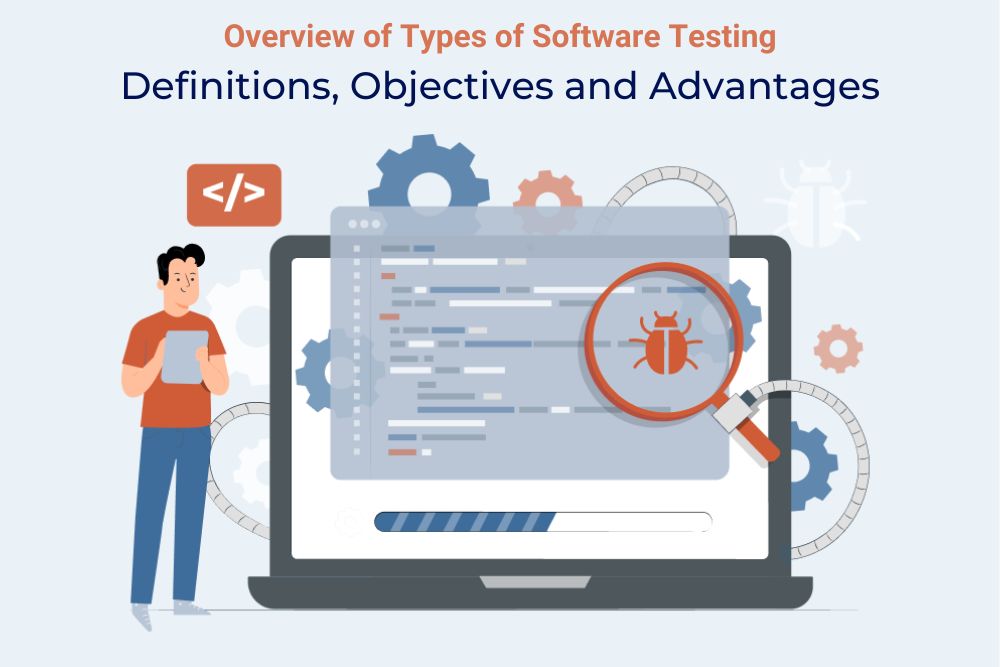Overview of Types of Software Testing: Definitions, Objectives and Advantages
In the world of software development, testing plays a crucial role in ensuring the quality and reliability of software products. Software testing is a process that involves the identification of software defects, errors or vulnerabilities and verifying whether the software meets the specified requirements. With the growing complexity of software systems, testing has become an essential part of the software development life cycle. In this blog, we will explore the different types of software testing, their benefits and how they can help businesses ensure that their software products meet the highest standards of quality and performance.

Software Testing
Software testing is a process of verifying the functionality of software to find any issues or bugs. It evaluates whether the developed software met the specified requirements and identifies any defects in order to produce a quality product.
Types of Software Testing
Functional Testing
Functional testing is used to verify the software against its functional requirements and specification. Such tests don’t take into account how a process works. Instead, it focuses on the process’ intended outcome.
It primarily has the following four goals:
- To evaluate the application’s essential features.
- To evaluate the application’s usability and basic navigation without any restrictions.
- To determine whether the system is user-accessible.
- To check if there are any error situations and to see if the correct error messages are being displayed.
Types of Functional Testing
White Box and Black Box Testing
White box testing involves testing the core aspects of software by examining its internal infrastructure and code. It can be implemented in unit testing, integration testing and system testing. In contrast, black box testing is done without any knowledge of the software’s internal code and is applicable in all four levels of functional testing, including non-functional testing.
Unit Testing
Unit testing is performed to validate the functions of a specific part or unit of software and is carried out using four techniques: branch coverage, statement coverage, boundary value analysis and decision coverage. The advantages of unit testing include granular testing for easier defect pinpointing, enhanced understanding of specific functions for onboarding employees, and the ability to perform tests on independent modules without concern for other system components.
Component Testing
Similar to unit testing, component testing accesses individual parts of an application, also called module testing. This type of testing is done by a QA professional in a black-box format and sometimes uses a stub and driver to simulate the interaction between components that rely on each other. The advantages of component testing include the ability to test the UI for usability and the ability to test against SQL injections for security reasons.
Integration Testing
Integration testing involves testing software modules that have been logically integrated as a group. Different types of integration testing include the top-down approach, the bottom-up approach and the hybrid approach. The advantages of integration testing include the ability to test many parts in one go, the ability to track system defects in earlier stages of the Software Testing Life Cycle (STLC) and the ability to test modules that interact with APIs and third-party tools.
System Testing
System testing is done after individual modules have been tested for integration and involve testing the entire system for failures or errors. This type of testing includes regression testing, functional testing and recovery testing. The advantages of system testing include the ability to test for the reliability of the system and its ability to recover from possible system crashes and the ability to ensure the system performs optimally without crashes.
Acceptance Testing
The final phase of software functional testing is where the client verifies if the product meets business requirements before releasing it. There are three types: Alpha testing detects major bugs, Beta testing allows end-users to provide feedback, and User Acceptance testing checks if it works as intended for the end user. The advantages of Acceptance testing are:
- It omits misalignment between tech teams and management
- Identifies red flags that can save from financial and reputational losses
- It instills confidence in stakeholders and business owners.
Non-functional Testing
Non-functional testing is a type of software testing that focuses on the readiness of an application from a non-functional perspective. It is conducted after functional testing and deals with non-functional aspects of the application, including performance, reliability and scalability. The objective is to ensure that the application meets the non-functional requirements and is optimized for user experience.
Types of Non-functional Testing
Volume Testing
Volume testing checks the application’s performance under high volumes of data to ensure it stays within tolerable limits. It can be used as a benchmark to calculate system scalability and can reduce maintenance and the overall risk of failure.
Localization Testing
Localization testing ensures software is customized for the targeted country and checks linguistic and regional aspects of the application. It reduces support costs, generates end-user loyalty and improves user experience and regional language support.
Performance Testing
Performance testing analyzes software performance and improves traffic retention. It includes load testing, stress testing, scalability testing, spike testing and soak testing. Performance testing improves scalability, ensures the application delivers the project’s vision and ensures users receive a frustration-free final product.
Monkey Testing
Monkey testing involves inputting random values and ensuring the application does not crash. It helps find out-of-the-box errors, breaks the system to find bugs and can be accessed by anyone with knowledge of the system or none at all.
Security Testing
Security testing is conducted to identify potential threats to the application, gauge overall risk and take necessary measures to keep hackers and data phishers at bay. The four types of security testing are vulnerability scanning, penetration testing, risk assessment and security audit. It provides a third-party expert opinion, tests cyber-defense capabilities and reveals unknown vulnerabilities.
Reliability Testing
Reliability testing ensures that software performs optimally for a set time duration under normal load conditions and reduces post-deployment costs by identifying repeating failures. It checks each operation of the software at least once and helps to find the structure of repeating failures.
Compatibility Testing
Compatibility testing measures how the software works in different environments and ensures it is supported across all environments that targeted users might be using. It enhances the software development process and identifies compatibility issues like UI defects, font variation, color variations, broken tables and broken frames.
Portability Testing
Portability testing determines the degree of feasibility in porting from one server to another, helping to future-proof the application. It helps in application scalability, identifies dependencies between two applications and ensures flawless performance on most common browsers and devices.
Different Levels of Testing
To check software reliability, performance and stability, there are three types of testing: Interface testing, Smoke testing and Sanity testing.
- Smoke testing assesses the core functionalities and helps detect 80% of bugs in the early stages.
- Sanity testing checks any functional issues of the software after introducing new features or changes.
- Interface testing is a type of testing that checks the communication between different software via an interface.
Summary
The software testing blog discusses various types of testing that software undergoes before it is ready for deployment. The blog covers functional testing, non-functional testing and other types of testing, including security testing, reliability testing, compatibility testing and portability testing. Each type of testing is described, along with its advantages and how it contributes to making the software reliable, secure and user-friendly. By following the best practices for testing, businesses can ensure that their software performs optimally, meets user expectations and delivers an excellent user experience.
Centizen
A Leading IT Staffing, Custom Software and SaaS Product Development company founded in 2003. We offer a wide range of scalable, innovative IT Staffing and Software Development Solutions.
Contact Us
USA: +1 (971) 420-1700
Canada: +1 (971) 420-1700
India: +91 63807-80156
Email: contact@centizen.com
Our Services
Products
Contact Us
USA: +1 (971) 420-1700
Canada: +1 (971) 420-1700
India: +91 63807-80156
Email: contact@centizen.com






